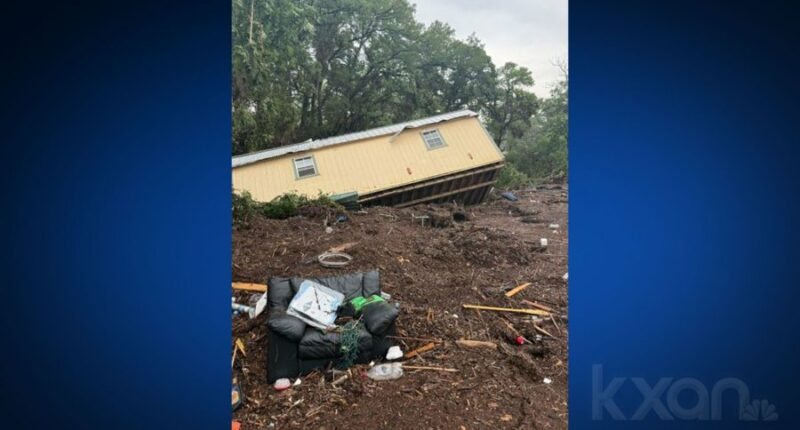Share this @internewscast.com

KERR COUNTY, Texas (Nexstar) — Susan Johnson heard the toilet bubbling in her Kerr County home at 4 a.m. July 4. She and her husband, Rick, knew they were in trouble as a wall of water approached their home in Ingram.
Within minutes, that water slammed into their house positioned between Bumblebee Creek and the Guadalupe River in west Kerr County. The couple had to swim for their lives in the darkness, clinging to a sycamore tree for nearly two hours as flood waters raged around them.
“There’s a difference between watching real hard and then a 32-foot wall coming down and hitting. There’s just no time, none,” Johnson said.
At least 134 people have been killed in the catastrophic flash flooding across Texas, with Kerr County suffering the heaviest toll. Officials said 107 people died in the county as of July 15, including 37 children, with 97 people still missing from the greater Kerrville area.
The Johnsons’ property sat at the convergence of two waterways– a geographic feature that helps explain why the Hill Country flooding proved so devastating across the region.
‘Perfect storm’ geography
Becky Etzler, executive director of the Riverside Nature Center in Kerrville, uses topographical maps to show visitors why the Hill Country experiences such severe flash flooding. The region’s steep terrain creates a natural funnel that channels water rapidly downhill from elevations exceeding 2,000 feet to areas below 1,600 feet in short distances.
Western Kerr County sits at the headwaters of the Guadalupe River system, where multiple tributaries converge after rushing down limestone hills. When heavy rainfall hits the area, water flows horizontally through underground rock formations until it reaches springs that feed the river.
“It’s the perfect storm, just geographically, in geology and through geologic features of, you know this rapid, rapid, and thus flash flood alley,” Etzler said.
Life-or-death escape
The Johnsons received alerts warning of extreme danger around 4 a.m., but the water rose faster than they could react. Johnson, a military veteran, used his training to guide his wife through chest-deep water to a window as their house filled rapidly. He grabbed his go-bag containing knives, flashlights and a whistle.
Outside, they faced roaring floodwaters that Johnson described as sounding like freight trains. In complete darkness, a flash of lightning illuminated a sycamore tree limb and they managed to grab it, pulling both of them to safety.
“If I missed that tree for whatever reason we were going to hit the flood, and I mean extreme flood and no human could swim against it,” Johnson said.
The couple secured themselves in the tree with Johnson’s web belt about 12 to 14 feet above the ground, enduring freezing water and wind for nearly two hours until dawn broke and water levels began dropping.
Once the immediate danger passed, Johnson organized rescue efforts for his neighbors. He helped evacuate elderly residents, including a 98-year-old man and his 83-year-old wife, and coordinated with first responders who arrived around 7:30 a.m.
The neighborhood effort ensured all 19 houses were safely evacuated, though most residents lost their homes and belongings. Johnson credited the community’s quick response and cooperation for preventing any deaths in their area.
Unprecedented flooding
Even facilities designed to withstand periodic flooding suffered extensive damage. The Riverside Nature Center, located in what officials designated a 500-year flood plain, experienced its first-ever inundation when both the Guadalupe River and Town Creek rose simultaneously.
Etzler said the center had never flooded despite numerous Guadalupe River high-water events over the years. This time, the facility sustained three feet of water in education buildings, destroying classroom materials and forcing complete reconstruction of damaged structures.
Starting over
The Johnsons lost their home of 13 years, both vehicles and nearly all possessions. They plan to relocate within Kerr County but will choose higher ground away from creek and river convergences.
Johnson said his military training helped him stay focused during the crisis, but he has no desire to face such conditions again at age 67.
“We’re alive,” he said. “Why should I be sad? We’re alive.”
A GoFundMe page has been established to help the Johnson family rebuild after losing their home and belongings.










